Why Do You Think a Cow Beef Bone Is Used in Science as a Dissection Specimen
Why a cow eye dissection? In big function, because of its similarities to the human eye.
The homo middle is one of the virtually complex and sophisticated organs in the body. Although it'southward small-scale and fragile, the center allows u.s.a. to see the earth without any conscious attempt. For example, it adjusts to light automatically. This process enables united states to run into in both starlight and the brightest sunlight.
The eye's automatic focusing system is faster and more than precise than that of whatsoever camera. While a camera lens must exist moved dorsum and along to accommodate for distance, the lens of the human eye simply changes shape. (Without this feature, similar cameras, nosotros'd need long tubes sticking out of our eyes!)
Each fragile part of the heart works together to provide information to the encephalon, and the encephalon interprets it instantaneously giving you a perfect epitome. It is an astonishing process.
Download: Moo-cow Eye Autopsy Lab
A moo-cow's eye, like other farm animal organs, is similar to our eyes. One benefit of a cow center dissection is that by examining the beefcake of a preserved eye, yous can acquire how your own eye forms images of the world and sends them to your encephalon. Some other is career potential: farmers, ranchers, and veterinarians (among others) must be intimately familiar with cow eyes to perform their jobs well.
This cow eye dissection kit comes with everything you need to conduct a lab exam.
Cow Heart Observation: External Anatomy
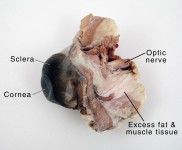 |
| Click prototype for full-size pdf |
Await carefully at the preserved moo-cow eye. The near noticeable office of the eye is the large mass of grayness tissue that surrounds the posterior (back) of the heart and is attached to the sclera. The second most noticeable office of the eye is the cornea, located in the anterior (front) role of the centre. Due to the fact that the eye has been preserved, the cornea is cloudy and blue-gray in color. It may besides be wrinkly and seem a flake 'deflated'. On the posterior side of the eye, nestled in the fat and muscle tissue, there is a noticeably round protuberance that feels stiffer than the surrounding tissue. This is the optic nerve, and it sends the images nerveless in the eye to the brain.
Cow Eye Dissection: Internal Anatomy
1. Place the cow's eye on a dissecting tray. The eye most likely has a thick covering of fat and muscle tissue. Carefully cut away the fat and the muscle. Every bit you get closer to the bodily eyeball, yous may notice muscles that are fastened directly to the sclera and along the optic nervus. These are the extrinsic muscles that let a cow to move its eye up and down and from side to side. Keep cutting close to the sclera, separating the membrane that attaches the muscle to information technology. After removing the backlog tissue, the sclera and optic nerve should be exposed but withal intact.
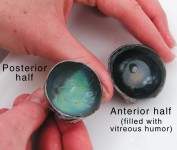 |
| Click paradigm for full size pdf |
2. Using a sharp scalpel, cut through the sclera around the middle of the eye and then that one half will have the anterior features of the middle (the cornea, lens, iris, and ciliary trunk) and the other half volition contain the posterior features (most noticeably where the optic nerve is fastened to the eye). The inside of the middle cavity is filled with liquid. This is vitreous humour. Depending on how the specimen was preserved, it will be either a dark liquid that will flow out hands or a slightly gelatinous material that you tin can pour out to remove. (In a living eye, the vitreous humor is clear and gel-similar.)
3. Flip the anterior half of the eye over so that the front of information technology is facing up. Using a pair of sharp scissors, cut the cornea from the center along the boundary where the cornea meets the sclera. When the pair of scissors have cutting in far enough, clear fluid will start to seep out – this is the aqueous sense of humor. While cut out the cornea, be conscientious to not accidentally cut the iris or the lens. After removing the cornea, pick information technology up and look through it. Although it is cloudy due to the degrading of the tissue, it is yet fairly transparent. Detect the toughness and strength of the cornea. Information technology is designed this manner to protect the more than delicate features found inside the center.
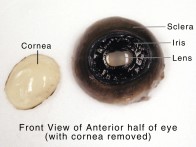 |
| Click image for full size pdf |
4. With the forepart of the anterior one-half of the middle facing up, locate the iris. Discover how the iris is positioned then that it surrounds and overlaps the lens. This position allows the iris to open and close around the lens to allow dissimilar amounts of light into the eye. In bright calorie-free, the iris contracts to allow in less calorie-free. In dim low-cal, such as at night, the iris expands to let in more than light.
5. Flip the anterior half over and examine the back half. Locate the lens and ciliary body. The ciliary body surrounds the lens, allowing it to change the shape of the lens to assist the eye focus on the object it is viewing.
6. Afterward examining both sides of the anterior half of the heart, pull the lens out. While the cow was alive, the lens was articulate and very flexible. In a preserved cow center, the lens will near likely take yellowed and become very hard. Even so, it may still be possible to look through the lens and come across its ability to magnify objects. Try this by placing the lens on a slice of newspaper with writing on it.
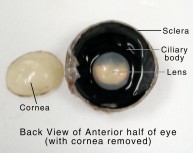 |
| Click image for full size pdf |
7. On the posterior half of the eye, there is a thin, tissue-like material that slides hands inside the sclera. This is the retina. The retina contains photoreceptor cells that collect the light entering the middle through the lens from the exterior earth. These images are sent to the optic disc, the spot where the optic nerve attaches to the center.
At this point, there are no photoreceptor cells; at that place are only nerves sending images to the brain. Because of this, this place in the eye is ofttimes referred to every bit the bullheaded spot since no images can be formed here. To recoup for this blind spot, the other eye oft sees the images that the first eye cannot see and vice versa. In rare occasions where neither eye tin see a particular spot, the brain 'fills in' the spot using the surrounding background information information technology receives from the middle. However, the 'filling in' of the bullheaded spot is not ever accurate. To run into this in action, try some blind spot experiments.
8. Virtually of the retina is not fastened to the center. Instead, information technology is held in place by fluids in the eye. The tissue of the retina gathers at the back of the middle where it forms into the optic nerve. This is the merely place where the retina is attached to the eye.
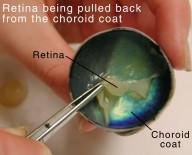 |
| Click prototype for full size pdf |
Use a pair of tweezers to gently elevator the retina off the inside wall of the heart. The retina may tear because it is very delicate. Underneath the retina, you volition find a very shiny and colorful tissue. This is the choroid coat. The choroid coat is also known every bit the vascular tunic because it supplies the eye with blood and nutrients. In a human eye, the choroid coat is very darkly colored to minimize the reflection of light which would cause distorted images.
9. Notice that the choroid coat in the moo-cow's center is very colorful and shiny. This reflective material is the tapetum lucidum, and its reflective properties permit a cow to see at night past reflecting the calorie-free that is captivated through the retina back into the retina. (While this does allow the cow to encounter improve at night than humans tin can, information technology distorts the clarity of what the moo-cow sees because the light is reflected so much.) The tapetum lucidum is also responsible for the 'glowing' eyes of animals, such as cats, when a small amount of calorie-free reflects off the tapetum lucidum in an otherwise dark room.
Resources
To observe your ain blind spot, bank check out our Blind Spot Experiments.
 Get a free catalog to conveniently browse for autopsy supplies + other easily-on science products.
Get a free catalog to conveniently browse for autopsy supplies + other easily-on science products.
Source: https://learning-center.homesciencetools.com/article/eye-dissection-project/
Post a Comment for "Why Do You Think a Cow Beef Bone Is Used in Science as a Dissection Specimen"